KALARIPPAYATT
http://shaolintemplemi.org/bodhidharma-the-first-patriarch-of-ch'an-buddhism.html
Editor's Comment: The above segment is from an apparent infomercial online by a Shaolin style martial arts studio in Madison Height, Detroit, Michigan, Master Boris Layupan, Instructor. His research chronicles how a Buddhist Monk from the "West" called "Bodhidharma" brought to Shaolin Temple and China the Mahayana Buddhism ("Zen" Buddhism) and martial arts, both of which then spread to Japan, Korea and other East Asian countries. The martial arts style practised by Shaolin Temple monks thus became the basis of Kung Fu, Karate, Taekwondo and all the other East Asian martial arts systems. We deeply regret the confusion caused by this segment, as well as other sites and some written publications about the place of birth of Bodhidharma. In the informercial that we mentioned above, the master makes the assertion that Bodhidharma hailed from either Kerala or Tamil Nadu, both of which are southern states in India, or from Persia. The truth is that the only place in the world where Buddhism, Martial arts (Kalarippayatt), and spoken Sanskrit language existed around that time, was in Kerala State in South Western India. Thus, the question of Tamil Nadu (a neighboring state to the east of Kerala) or Persia as his birthplace is misplaced. Tamil is a purely Dravidian language, with no Sanskrit words and Tamil Nadu had very little exposure to martial arts, except in the regions that are contiguous with Kerala. The inscriptions about Bodhidharma's teachings on the walls and elsewhere in Shaolin temple are in Sanskrit language, which was spoken, along with the local Malayalam language in Kerala. Also, even now, the profound influence of Sanskrit is evident in the Malayalam language. I am not sure if Persians practsed Buddhism, and were actively engaged in spreading it to other counties, but certainly they were not speaking Sanskrit, or practicing Kalarippayatt. Thus, it is a far cry to give them any credit for exporting the martial arts to the Chinese. The Shaolin style of martial arts has unmistakable resemblance to Kalarippayatt in their movements, the weapons used, as well as their exposure to Yoga and Meditation as practised by the Indians in general and Buddhists and Hindus in particular. Now, let us explore our subject matter, KALARIPPAYATT:
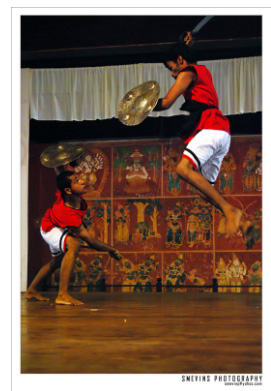 I
I
The unwieldy name Kalarippayatt in Malayalam language means school fight or staged fight (kalari= school, payatt= fight) and is the indigenous martial arts system of Kerala state. This system of martial arts has several distinctions. First it was the first organized system of martial arts in the world. Second, it teaches a comprehensive system of discipline and health including flexibility training, massage, hand to hand combat, use of weapons, use of marmas (pressure points), Ayurveda treatment modalities, meditation and yoga. In other words, the system focused not only on warfare but on promoting mental and physical well-being and incorporated treatment modalities. The system’s emphasis on flexibility rather than speed and power (which most of the Eastern Asian martial arts focus on) is a unique feature of Kalarippayatt. Children had traditionally been inducted into this martial arts study very early in life, again with special emphasis on massage and building flexibility. Finally, no other system ventures into the world of treatment, meditation or yoga.
The origin of Kalarippayatt has been traced back to at least 525 CE, but the actual beginnings of the system is not known. However, martial arts scholars believe the systems had been in existence from antiquity. Hindu mythology has recorded that the system was handed down to a sage named Parasuraman from Lord Shiva. The sage (who is believed to have retrieved the land presently called Keralam from the sea) then taught the system to 64 warriors and established numerous kalaris, temples and vedic schools. The Thekkan, or southern system of Kalarippayatt, is believed to owe its origin to the sage Agasthya, one of the immortals according to Hindu mythology. The use of yoga practice and marma (pressure point) are emphasized especially in the southern system.
Keralam, the home of Kalarippayatt, is a small state in the southernmost part India, to the West of the Western Ghats. The two systems (Vadakkan or Northern and Thekkan or Southern) have similarities but also significant differences. Both styles have been practiced in the contiguous regions of neighboring states of Tamil Nadu and Karnataka respectively.
SPREAD OF KALARIPPAYATT:
Kalarippayatt was brought to China and to the Shaolin Buddhist monks by an Indian Buddhist monk named Bodhidharma aroung 525 CE during the rule of Emperor Wu of the Ling Dynasty. The Shaolin temples carry written records of this interaction on their walls. Bodhidharma taught the Shaolin monks the eight ‘adavukal’ (adavu=technique in Malayalam) or the eight hands of the Buddha. These form the basis of the Vadakkan or Northern style of Kalarippayatt. Kung Fu, Karate, Tae Kwondo and all other offshoots and incarnations of martial arts share several features with Kalarippayatt. Central to all styles of martial arts is the flexibility training and means to harness power through speed, focus and technique and the use of various weapons. However, no other form (other than Kalarippayatt) incorporates meditation, Yoga and Ayurvedic (or any other form of) treatment principles into the curriculum of martial arts. Although flexibility is emphasized in all systems, Kalarippayatt is the only one that regards it as the most important ingredient.
SYSTEMS OF KALARIPPAYATT AND THE MAIN INGREDIENTS:
There are two main styles, the Vadakkan and the Thekkan; the less common Kathinayoga is also the most difficult. I will restrict my further discussion to the two common styles and only occasionally mention the third style in passing, when the need arises.

In both systems the kalari is rectangular in shape 42ft in length and 21 ft in width. The Northern system uses a pit dug out approximately 3ft deep. Then a 5ft wall is constructed around the site. This type of kalari is known as “Kuzhikkalari” (“Pit” kalari). In the Southern system an area of approximately the same measurements is used but at ground level. This is called “Tharakkalari” (Thara= floor or ground) and allows for more free movements for the Kalari warriors. A thatched roof is constructed over the kalari pit. In both systems the kalari is situated in an east-west direction, and at the southwest corner the kalari deities are placed and devotional lamps lit.
“Ankakkalari” is a kalari with special dimensions and is meant for staged duels in the Kathinayoga style. The measurements of the pit are 56ftx28ft. Kalari is in more natural surroundings, and the floor area is filled with river sand. This is meant to protect the contestants from severe injuries, as this style uses slamming maneuvers.
KALARI ETTIQUETTE:
When a kalari student enters the school he/she pays respect to the teacher by remaining prostrate on the floor before him. Then the teacher blesses the student and hands him/her the weapon(s). Respect is also paid to the deities by lighting the lamps and praying.
WEAPONS OF KALARIPPAYATT:
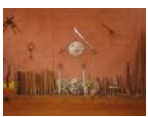
1) PIRAMBU OR NEDUVADI (Long Staff):
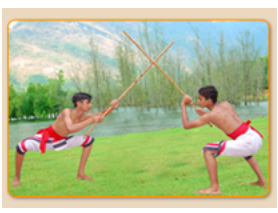
This is a long stick made out of wood, approximately 1 inch thick and of a length equal to the distance between the operator’s ear to the ground. The students practice use of the staff first solo with swirling, twisting and turning movements. With adequate practice, a student becomes adept at using the staff, and expert practitioners have been known to be able to use it so fast that it can be used above head to ward off rain drops! Prearranged sparring with partners is done after the student has gained confidence in using the staff. The use of staff is a very effective means of defense and offense as well as strengthening the forearms and wrists.
2) GADHA (Club):
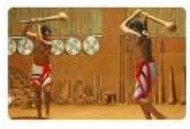
This weapon is made of wood, with a long handle and almost spherical heavy ball at the business end. It is heavy, its use is unwieldy, and it requires great strength. Its length is 3-4ft, and the grasping end is 3-8 inches in diameter.
3) KURUNTHADI (Short stick):
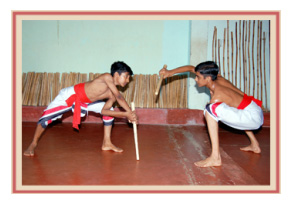
This is made out of the trunk of palm tree and measures 2ft x 1-11/2 inches. More rapid movements are possible with kurunthadi than with the long staff, and submission holds as well as grappling are practiced with the use of the kurunthadi. Adept use of the short stick is a prerequisite for the safe practice with daggers.
4) DAGGER:
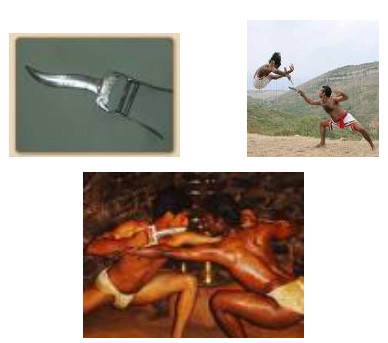
By the time a student is allowed to use a knife or dagger, he/she has attained sufficient proficiency that serious injuries are rare. The use of a knife/dagger entails blocking and evasive techniques as well as attacking. As no protective gear is worn, extreme concentration is required for the safe use of a dagger.
5) VETTUKADI (Machete):
The training with this weapon is similar to that of the dagger, but since machete is essentially a household implement, it is widely available for the kalari practitioners and is thus useful in street fights.
6) VALUM PARICHAYUM (Sword and shield):
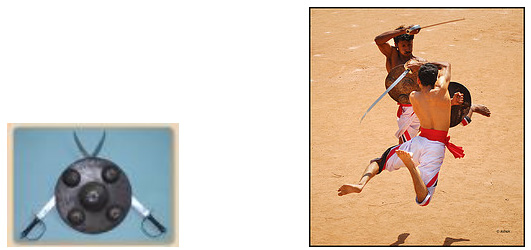
From the early years of kalarippayatt, the sword was the most important weapon. In fact, folk heroes like Thacholi Othenan were most celebrated for their dexterity with the sword. While the sword was usually used along with a shield, at times it was used without a shield and at other times a sword was used in each hand.
7): URUMI OR CHUTTUVAL:
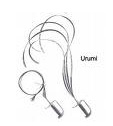
This is a long, flexible, double-edged sword made of steel. The length of the sword is measured from the fingertip of an outstretched hand to the fingertip of the other hand. It is 1-2 inches wide. By the very nature of the urumi, it is the most dangerous of the weapons to use and one that requires a great deal of training, skill and marked concentration. In fighting situations, urumi can be valuable in fending off multiple opponents; this is especially so when the urumi is fitted with two or more blades. Another attractive feature of urumi is that it can be worn on the waist like a belt and thus it becomes part of the attire and is then readily available for situations.
7) KOTTUKAMBU (Small stick):
This lethal weapon is made from the wood of a palm tree or areca nut tree. It is about the thickness of one’s thumb and only about as long as the span of an outstretched palm from the tip of the thumb to the tip of the little finger. In the hands of masters, it becomes a deadly weapon for striking the marma points. Only students with great dexterity and experience are trained in this lethal weapon.
KALARI UZHICHAL (Oil Massage):
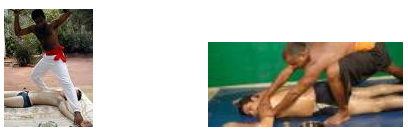
An integral part of Kalarippayatt practice is massage using medicated oils. Oil is applied on the prostrate body and rubbed in using the feet usually by the kalari master. This application is combined with maneuvers to enhance the flexibility of the student. Also, the medications that are incorporated in the oil have been carefully selected for their therapeutic value for treating rheumatic conditions and injuries.
KALARI YOGA, AYURVEDA AND MEDITATION:
Yoga maneuvers, meditation and the various Ayurvedic (indigenous treatment system of India) therapeutic modalities were also incorporated into Kalari curriculum. The masters of Kalari schools kept such treatment modalities as secrets and passed them down from generation to generation. As mentioned above, this comprehensive body/mind treatment regime is unique to Kalarippayatt and not part of any other martial arts system.
MARMA CHIKILSA (PRESSURE POINT):
The Kalari instructors were very adept at manipulating the various vital points on the body as outlined in Ayurvedic medicine (Shushruta Samhita). The following Figure shows some of the pressure points as identified by the Kalari Marma treatment system.
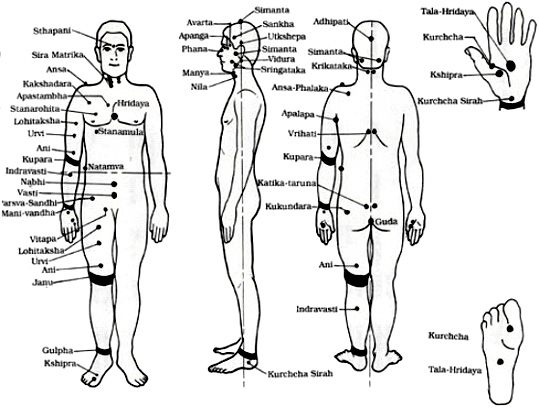
SOME PERSONALITIES OF NOTE IN KALARIPPAYATT HALL OF FAME:
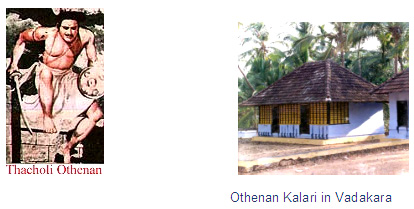
Ballads from the Northern parts of Kerala (practicing the Northern style) narrate stories of heroes and at least one heroine. The most prominent among the heroes was Thacholi Othenan (in present day Vadakara, in Kozhikode District). He was so proficient in the use of sword and shield, he was considered invincible. Finally, an opponent came up with a scheme in which he (Othenan) was lured by a beautiful woman and drugged. While he was incapacitated, his sword was tampered with so that it would break easily. As one could imagine, during the ensuing duel his sword broke and Othenan was killed.
The story of Unniarcha is equally compelling. She was the student of a very notable Kalarippayatt Master called Aromal Chekavar. One evening on her way to the temple a gang of hooligans decided to molest her. She single-handedly defeated a gang of about six men, without even using any weapon, and did not let them go until their leader who instigated this standoff apologized to her.
The above photographs were submitted by Bhargava Kalari (Jimith Mohan). You may contact Jimith at the following email address: jimithmohank@gmail.com
More Photographs from Othenan's Kalari (taken in Dec. 2019)